


 |
May 10-26, 2019: A Trip to Fort Lauderdale |
 |
April 6-10, 2019: A Trip to Houston |
 |
Return to the Index for 2019 |
There is an exhibit of bronze sculptures by Gary Lee Price entitled "Celebrate the Children" that has just started at the Dallas Arboretum, so we thought we would take advantage of a nice Sunday afternoon to head over there and walk through the gardens.
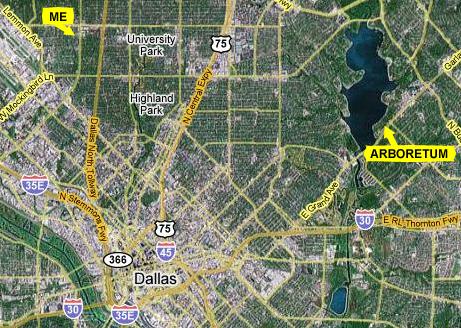 |
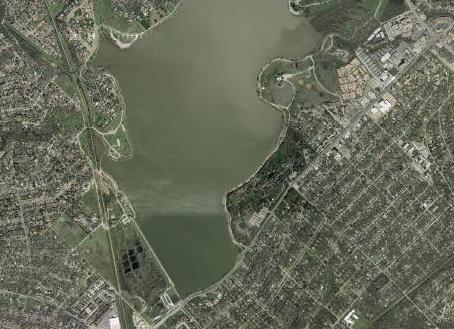 |
The bike path used to cross the top of the dam, but for one reason or another, the bike path was rerouted some years ago, and now it goes through some parkland and playing fields south of the dam, across the spillway, up Garland Road for a ways, and then back north along the lake shore.
You can also see a closer view of the Arboretum in this picture, and can begin to pick out some of the pathways through the gardens.
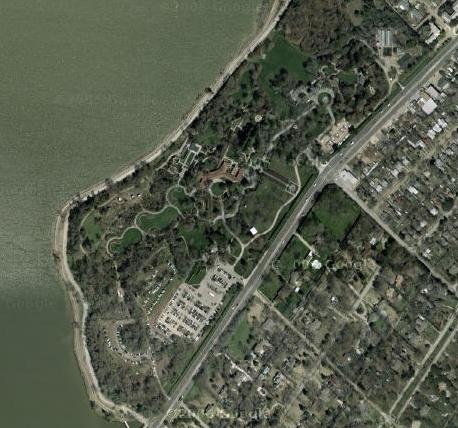 |
You can also see the maze of pathways that criss-cross the gardens.
Today we are just going to wander around along no particular route, but we do want to try to see all the sculptures. We picked up a special exhibit brochure at the entry so we could see where all the sculptures were located. I'm also going to mark that map with some of the locations where we took pictures today.
|
We began, as we always do of course, by coming in to the Arboretum through the Ginsburg Family Plaza (A).
|
This is also where we found the first two of Price's sculptures- Flight Time (Boys) (10) and Flight Time (Girls) (11), both seen at left in a picture with Fred.
The plaza is home to the Trammell Crow Visitor Education Pavilion. Built with native Texas limestone and wood and copper sheathing, this structure serves as the gateway to the gardens. Upon entering, visitors will are in the Ginsburg Plaza that also features the Junkins Fountain; the plaza is enveloped by a menagerie of seasonal flora. This entryway gives visitors a glimpse of the 66 acres of stunning vistas ahead. There are kiosks here where guests can purchase admission, parking and memberships. On occasion, live choral performances and other live music take place just inside the ticket booth, welcoming guests.
The sculptor of the current exhibition "Celebrate the Children" is Gary Lee Price, and he had something to say about each of the 19 sculptures we saw today in the gardens. Of the two versions of "Flight Time", here is what he had to say:
| "We've all done it- either been the twirled or the twirler. Remember the rush, the balance, and finally trying to stay upright after the dizziness. I think most of all we remember the laughing and the pure fun as the world continues to spin while we've stopped. Perhaps this is one of our first "air-borne" maneuvers that endows us with that sensation that we really can fly- both in body and in spirit. Maybe we should all regularly get a little "flight time" just to get us off the ground a bit and help remind us to keep the proper perspective on things, to laugh more and have a little more fun! A note of interest: my son, Isaiah, who was my original model for the "twirler", is now a pilot flying tours over Lake Powell in southern Utah. He's always been interested with flight in one form or another. I captured him at age 12 flying his brother- now a decade later he's flying French tour groups! Wow- life's continuum!" |
Our usual route through the Arboretum takes us next to the newest garden area at the Arboretum- "A Tasteful Place".
|
This 3.5-acre, potager garden, pavilion, and kitchen is inspired by the movement toward growing and eating fresh, sustainable, locally-grown food. There are three daily tastings made with seasonal produce, and the pavilion offers cooking demonstrations.
|
|
These gardens, while small, are very nice, flanked on the west by the Pavilion and Tasting Terrace and on the east by the pergola overlook down into another new part of the garden where there is a fountain and watercourse. Most of the plants here in A Tasteful Place are either herbs or actual food plants, although they are manicured and don't look much like a farm. Below are thumbnails for some of the many pictures we took today here in this garden:
|
Here is what Price had to say about the two versions of "Green Thumb" that we found here in A Tasteful Place:
| "Green Thumb II: To display with pleasure one’s effort – that’s what this garden piece is all about. Just as important as all the hard work is taking time to enjoy the fruits of our energy. Hardly anything gives a greater sense of accomplishment than working in the soil with our hands to help reveal nature’s masterpieces. In winter climates your gardener’s flower box can also be used as a bird seed holder.
Green Thumb III: |
Earlier, you saw a panoramic view of A Tasteful Place taken from the south entry to the garden from the Ginsburg Plaza. Here is another view of the garden, this one taken looking east from the Pavilion on the west side of this new garden:
|
We walked east to the pergola overlook down into the Three Sisters Lagoon and Fountain (C); here is the view from that overlook:
|
From the overlook, there is a curving walkway down into the area around the Three Sisters Lagoon, and we descended that shady walkway down to the watercourse and the lagoon.
|
|
I also made a couple of movies here:
|
I made this movie as we were down by the bridge crossing the watercourse that flows into the Three Sisters Lagoon. |
In this movie, you can come along with us as we walk up he pathway from the lagoon to the Jonsson Color Garden. |
The Jonsson Color Garden is always a pleasure to visit; it is basically a series of three open lawns surrounded and divided by walkways and bordered by seasonal plants in huge beds.
|
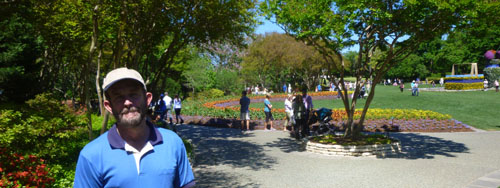
Designed by Naud Burnett II, the 6.5-acre Margaret Elisabeth Jonsson Color Garden features large, sweeping beds of seasonal flowers and plants and is a popular place for families and picnics. It is also one of the many locations for holiday displays throughout the year, as it was today with a large "Easter picnic" display. Here are that display and a closeup of one of the seasonal flowers:
|
|
Finally, here is a panoramic view looking south across one of the lawns of the Jonsson Color Garden:
|
Next, we continued eastward into A Woman's Garden, with its symmetrical reflecting pools, beautiful stairstepped fountain and pocket garden (E).
|
| "The very word puts a smile on our faces and gives us vibrant energy and optimism for jobs well done. It also causes upward motion. It is this 'zest for life' that I attempted to capture in my exuberant figure. I think we should celebrate ours and other's 'wins' more and spread the GOOD NEWS! Life is short – let us enjoy it!" |
The Woman's Garden is located just north of the old DeGolyer House (the DeGolyers being the earliest patrons of the Arboretum, and to which they donated their house in their will) and right alongside White Rock Lake.
We walked through the garden and its side pocket gardens, and here are some of the pictures from that walk:
|
Continuing east from A Woman's Garden, there are two water features on the north side of the garden [(F) and (G)] near the lake. Both of them are part of artificial streams that run through the garden.
|
Here are more of the pictures we took right around this first water feature:
|
Walking a bit further, one comes to the second of these two lagoons, this one being at the bottom of the artificial stream that runs down from the main garden walkway- the Paseo de Flores.
|
(Mouseover Image Above for Video Controls) |
I made a movie here at the pool, and you can use the player at right to watch it. And here are some of the other pictures we took here, before we headed back up towards the Lay Family Garden:
|
From the bottom of the Red Maple Rill, we walked around to the east side of the Rill and walked up along the Martin Rudchik Performance Stage and Lawn until we came to where we could take the walkway into the Rill itself. Here is a panoramic view of the performance stage and the lawn, both of which are between the Alex Camp House and White Rock Lake:
|
Here are two nice views talked as we walked up through the Red Maple Rill (always a very nice place to stroll here in the gardens) [(H) and (I)]:
|
|
We continued up towards the Seay Magnolia Glade, an area with a meandering stream amid mature magnolia trees, and there we found the next of the Price sculptures, this one entitled Etch‑a‑Sketch (8).
|
|
Here are Price's comments about this particular piece:
| "So many times in our busy and responsible lives as adults we forget about Thoreau's advice to "simplify, simplify, simplify". Children remind us of that as we spend time with them appreciating the little things. Like looking for four-leaf clovers in the lawn, like watching the fuzzy caterpillar inch along, and also simply laying on our backs as we watch the clouds and the birds sail by. Have a seat with these two as they enjoy their 'Time Together'." |
Moving into the Lay Family Garden (L), we first walked around the north end of the garden, coming up to the new waterfall.
|
Fred also took what I thought as a really neat picture of one of the blooms here in the Lay Family Garden:
|
The Lay Family Garden has three more waterfalls at its south end; these have been here much longer than the Grotto. They are part of a more "mid-century modern" structure, but are often not running. The Grotto runs continuously.
|
|
|
The lawn in the Lay garden was set up for an event, but it seemed to be lightly attended:
|
Here are Price's comments regarding the two sculptures in "Beginner's Luck":
| "Every summer as a youngster, my grandfather would have me get on the train and travel across southern Idaho to Gooding. He and my grandmother would pick me up at the Shoshone train depot. En route I'd contemplate the great times I'd have for the next 2 or 3 weeks. My grandparents made sure my every need and whim was well taken care of. A big part of my annual trek was the fishing trips. Although I took artistic license in exaggerating the extent of the beginner's luck, more often than not my grandpa's wisdom far outperformed my enthusiasm, thus helping me appreciate all the more when I'd catch the first fish. I dedicate 'Beginners Luck' to grandparents and parents alike that spend the time with their kids and grandkids figuring out life at the end of a fishin' pole. There's plenty of room on either bench for you or your friends to join in!" |
From the Lay Family Garden, we walked the short distance over to the entry plaza for the Rory Meyers Childrens Garden, and there we found two more Price sculptures:
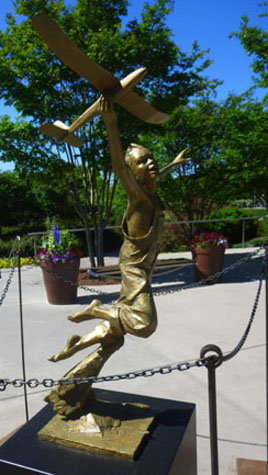 "Wings" (16) |
(Picture at left) "Zac, my oldest boy, modeled for this piece when he was nine. His long, thin body was perfect for this piece; it was as though his arms really were wings reaching out. “Wings” is one of my favorite pieces. It’s a very therapeutic piece for me; it represents the freedom and the joy we so often lose in our busy lives. The glider becomes a symbol of our dreams and aspirations. It also focuses on flight, which represents our ability to rise above our problems."
(Picture at right)
|
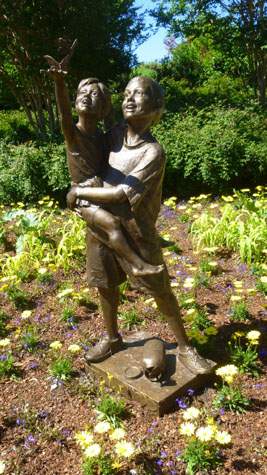 "New Seasons" (19) |
From the Childrens Garden entrance, we took the walkway south of the Lay Garden to get back to the fountain by the Alex Camp House.
|
| "This piece was inspired by the bird lovers in my family. This sculpture is dedicated to those of us who enjoy the ornithological world and find simple pleasure in watching them flutter about. Think about it. What would our world be like without birds?" |
As we came back past the south entrance to the Lay Family Garden, Fred posed for beside a particularly colorful stand of verbena. As you can see, other garden visitors were using these flowers as backdrops for their own pictures.
We passed south of the fountain in front of the Alex Camp House because in the little garden area south of the house we saw another group of Price sculptures.
|
In the artist's words:
| "Nothing exemplifies the enjoyment of open spaces like kids doing cartwheels. As I watched these kids playing in the park, I tried to capture their enthusiasm and adventuresome nature; qualities that at times we lose sight of. I hope these kids remind us to have fun in all that we do!" |
If you want to see the sculptures individually, here they are:
|
I really enjoyed the "Cartwheel Kids", and as you can see in the photos, they were popular with lots of guests. If I had an extra $60K lying around, and a lawn to put them on, well...
We went out to the Paseo de Flores to head west back towards the entry plaza, and between the Alex Camp House and the Trial Gardens, we found two more Price sculptures.
|
|
| "Planting and growing things is nothing short of magical. I remember as a youngster planting my first marigold seeds and diligently watering and waiting. Nature did her thing and I was ecstatic! And then as they continued to grow and blossom, well, the magic has never left. This piece represents that magic, that joy that comes via faith, hard work and finally, the splendid results. Also, in creating this piece I was trying to create a great silhouette. I love sculpting children with arched backs because it is such a great gesture. Having the boy and girl each holding a basket was a great way to not only achieve that look, but have them work together as a team, kind of the yin and yang principle." |
|
The next Price sculpture, one of the largest, we found at the top of the Crepe Myrtle Allee- right where it branches off to the south from the Paseo.
|
| "To be able to fly is so symbolic of freedom and possibilities; and flying around a sphere, to me, represents the joy we experience in this life, and in the sphere of worlds to come! Imagine a world without limits, without boundaries, without prejudice and blame. Imagine an existence full of self-confidence, self-esteem and not only tolerance, but love for others regardless of color, socio-economic or any other standing. To me that is what the future holds. That is what children represent and that is the type of world I would like to help others imagine so it can come to pass. I believe sculpture can have a tremendous, uplifting influence on us and so I envision this piece as a large, life-size work where its message can ring loud and clear. "Celebration!" is just that, a celebration of life and aspirations." |
Continuing west along the Paseo, we saw another sculpture up on the circular lawn just south of the DeGolyer House, and so we walked over to have a look.
|
| "As I've watched our children and their friends catapult themselves up and down on those fun contraptions called pogo sticks, I couldn't help but want to capture their joy and excitement as they master the balance and synchronicity of this fun toy. It seems very Leonardo Da Vinci‑ish to me; a simple but ingenious invention launching children off to new heights of adventure and discovery. My sons Zac, Isaiah and Tyrone and lots of their friends served as models for this piece. It was fun watching them "pogo" hundreds of times without stopping as I photographed them. It was particularly enjoyable playing with the design of the piece and figuring out how to have certain figures suspended in the air. For me its design is kind of an 'explosion' of life." |
South of the DeGolyer House, and across on the south side of the Paseo is the area where the Fall pumpkin festival is always held, although of course today it's just open lawn with some springtime plantings. But over in that area we spotted the next-to-last Price sculpture.
|
| "I watched on television an interview with a former white supremacist. At age eighteen, he was imprisoned because of his violent anti-racial acts. The interview became very interesting to me as he recounted his reformation while in prison. He told how, prior to his sentence, he vehemently avoided people of other races. Simply: they were to be hated, they were to be abhorred, and they were to be despised. For a time, he was in solitary confinement. Overnight, he was placed in an environment where interaction with men of many colors and from many cultures was a welcome experience. Relationships developed. Biases subsided. Upon release from prison, he found himself free from the prejudices and bondage that previously had tied his hands and soul. Today, he takes a radical stand against such actions, like those found in his own sordid past, by speaking out in public forums. He exposes the thought process and violence of hate groups. He coaches a multi-cultural youth hockey team. This story fascinates me. The prejudice could only occur when there was no interaction. When the associations were built, the barriers were destroyed. Friendships occurred. This idea is what "Circle of Peace" represents; portraying children from all walks of life playing with and enjoying each other. The circle that the children form represents the continuum of humanity. The clasped hands represent the interaction and cooperation, together with compassion and respect, which engenders humanity. Respect for each other’s uniqueness bridges the gap between any indifference." |
We continued walking back towards the entrance, and as we came by the Test Garden Beds, where there are always beautiful seasonal plantings, we found the last of the Price sculptures.
|
| "I remember one of the greatest discoveries of my childhood was planting some marigold seeds, caring for them, and watching the miracle slowly take place right before my eyes. It instilled within me a sense of accomplishment and awe for Mother Nature and the majesty with which she works. This little guy is beginning that journey. Not only do his plants grow, but also his faith and his appreciation for the way things work. This is the boy version of "Candice" only I had to include a bug – a katydid. My model, Morgan, was very helpful and excited to pose for this sculpture." |
So that was our visit to the Arboretum today. I hadn't known about the sculptures on display, so it was a surprise to see them, and gave us something to look for as we walked through the gardens.
You can use the links below to continue to another photo album page.
 |
May 10-26, 2019: A Trip to Fort Lauderdale |
 |
April 6-10, 2019: A Trip to Houston |
 |
Return to the Index for 2019 |